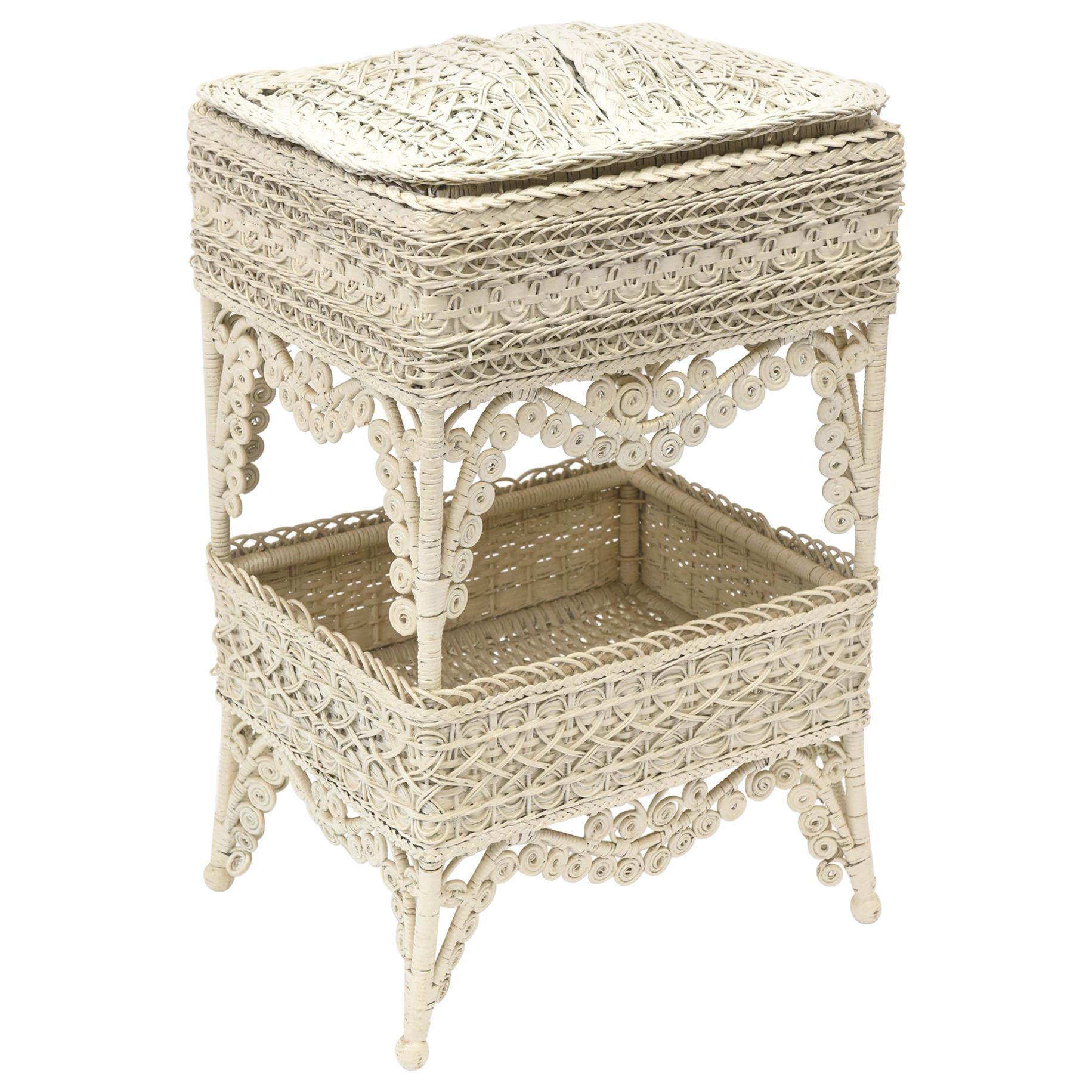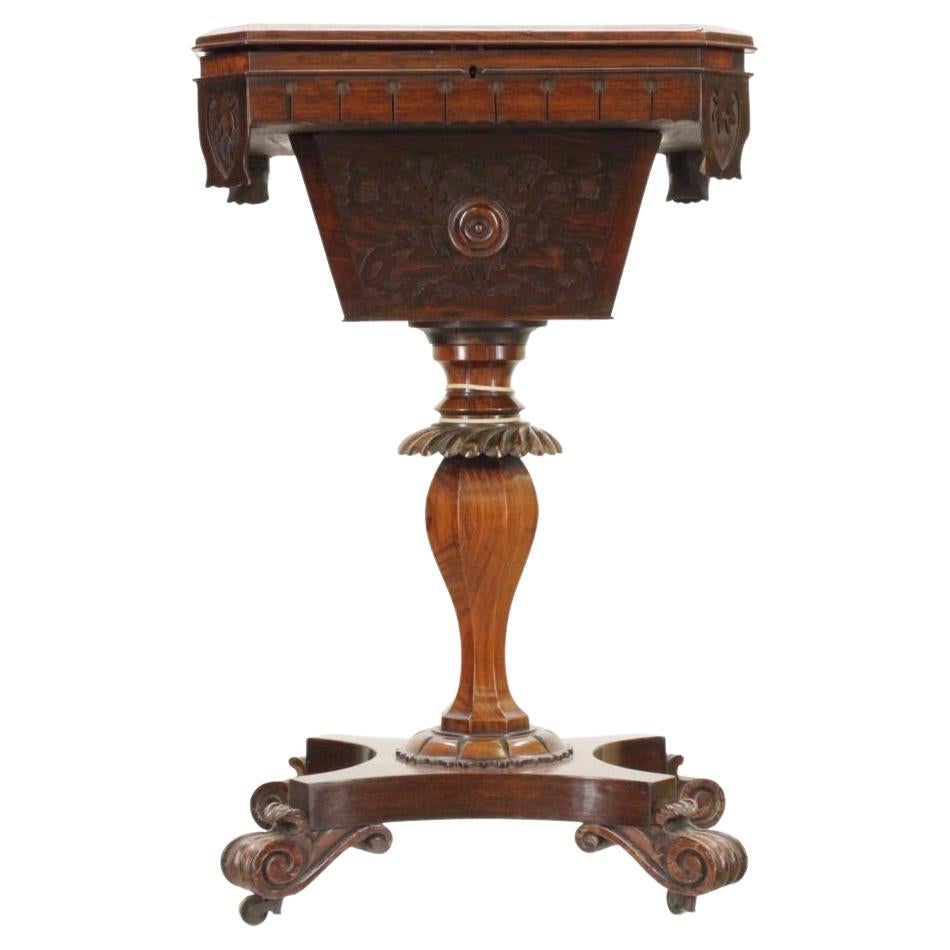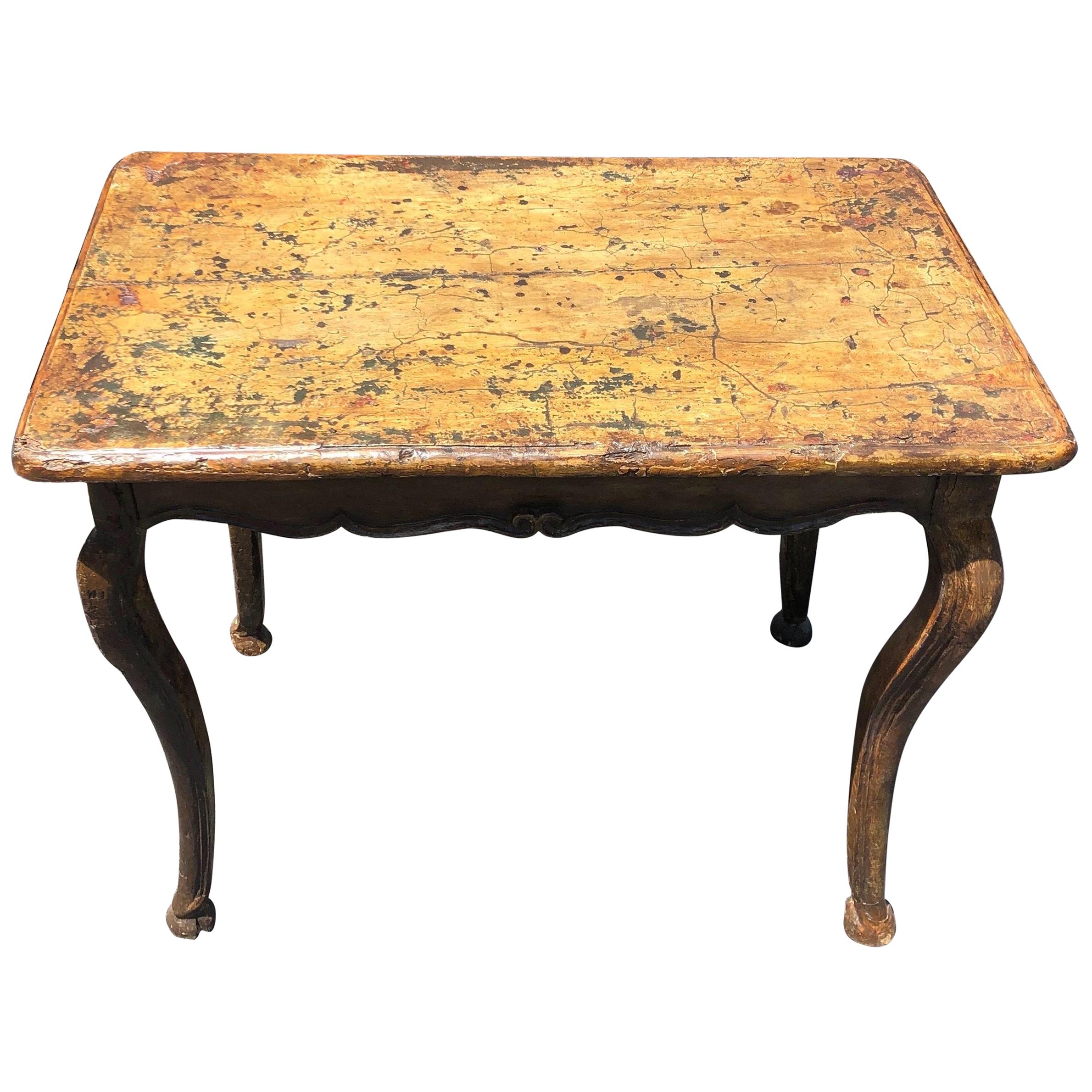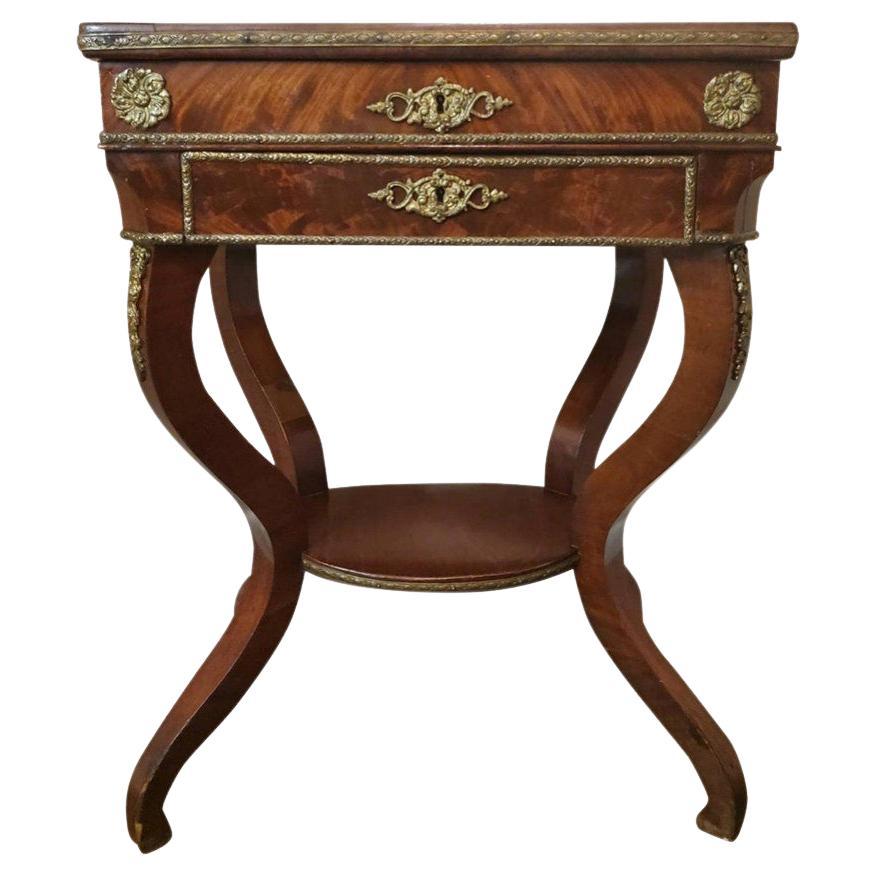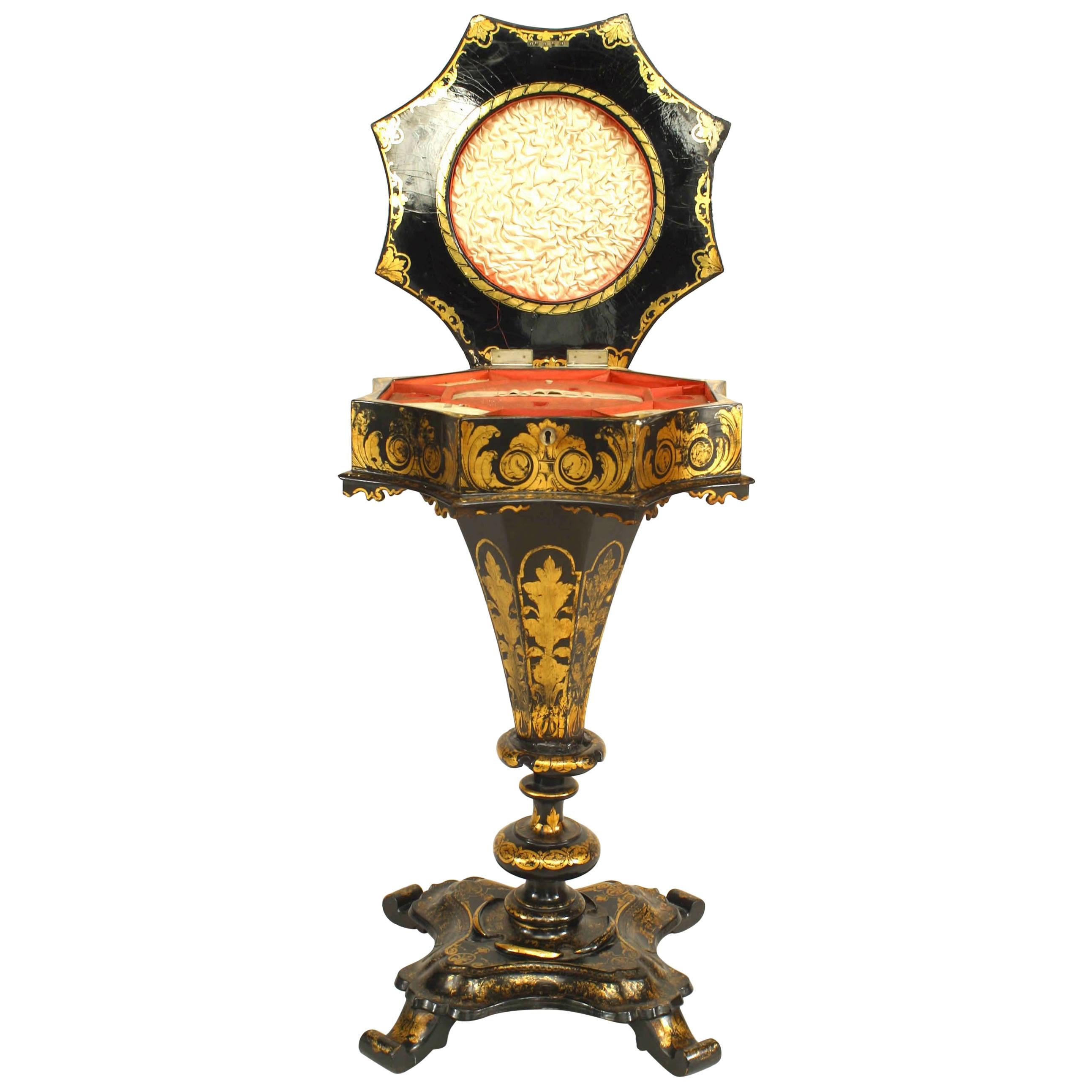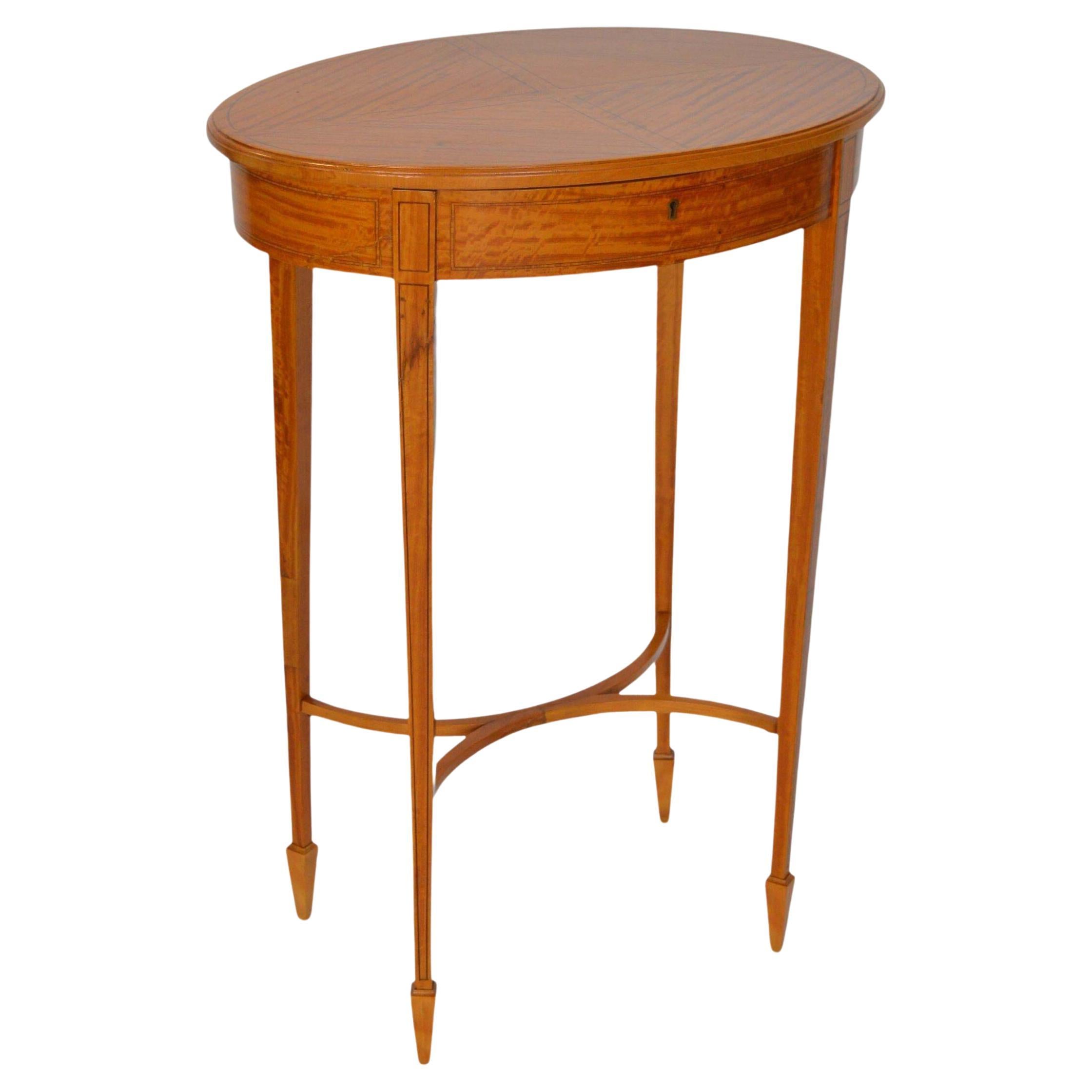Items Similar to Victorian Black Lacquer Paint Decorated Sewing Stand 19th C.
Want more images or videos?
Request additional images or videos from the seller
1 of 21
Victorian Black Lacquer Paint Decorated Sewing Stand 19th C.
About the Item
High End Victorian sewing stand in very good, original condition. The stand features a hand painted foliate themed top, depicting ferns surrounded by a geometric gilt border. The turned vertical standard and cabriole legs also display hand painted polychrome trim on a black ground. The hinged top opens to reveal a fitted interior, upholstered in purple satin fabric, with off white satin trim, and brass handles.
The stand is in very fine, original, clean and ready to use condition, showing only light cosmetic wear normal and consistent with age.
19th C vintage, English, or American in origin, unsigned. Elegant, charming and decorative antique table, perfect accent piece for your home.
- Dimensions:Height: 27.5 in (69.85 cm)Diameter: 18.5 in (46.99 cm)
- Style:Victorian (Of the Period)
- Materials and Techniques:Wood,Hand-Painted,Lacquered
- Place of Origin:United States
- Period:19th Century
- Date of Manufacture:19th C.
- Condition:Wear consistent with age and use. Very fine, original condition, showing only light cosmetic wear, normal and consistent with age.
- Seller Location:New York, NY
- Reference Number:1stDibs: LU978735258482
About the Seller
4.8
Platinum Seller
These expertly vetted sellers are 1stDibs' most experienced sellers and are rated highest by our customers.
Established in 2013
1stDibs seller since 2013
3,374 sales on 1stDibs
Typical response time: 1 hour
- ShippingRetrieving quote...Ships From: Cohoes, NY
- Return PolicyA return for this item may be initiated within 1 day of delivery.
More From This SellerView All
- Mechanical Adjustable Patent Victorian Chair Table after HunzingerBy George HunzingerLocated in New York, NYInteresting mechanical folding chair/table from the Victorian period. The chair backrest folds down to become a table surface, this style known as patent, or proto furniture was popu...Category
Antique Late 19th Century American Late Victorian Chairs
MaterialsUpholstery, Oak
- Antique 19th Century Iron Fence Post in Original Paint SurfaceLocated in New York, NYImpressive architectural iron fence post in original old paint finish, constructed of cast and wrought iron. The post features a exterior cage of re...Category
Antique Late 19th Century American Late Victorian Architectural Elements
MaterialsWrought Iron
- Set of Five Graduated Hand Painted Brass Temple Bells Chinese 19th C.Located in New York, NYSet of five graduated hand painted brass temple bells, in good, original, vintage condition, We believe there charming bells are 19th C vintage, made in China, however we are not exp...Category
Antique 19th Century Chinese Chinese Export Metalwork
MaterialsBrass
- 19th C Gilt Salon ChairLocated in New York, NYWe believe this is a Late 19th, or Early 20th C gilt wood salon chair in as found condition. This elegantly carved wood arm chair is structurally sound...Category
Antique Late 19th Century French Louis XVI Armchairs
MaterialsUpholstery, Giltwood
- 19th Century Empire Tub ChairLocated in New York, NYSolid walnut frame, pegged construction, carved wood frame, upholstered seat and back - upholstery worn and will need to be replaced. Rear leg shows minor loss at base, as pictured. ...Category
Antique 19th Century American American Empire Lounge Chairs
MaterialsUpholstery, Walnut
- 19th C French Metal Wine ChestLocated in New York, NYUnusual metal wine chest / trunk constructed of iron and steel. The chest is in the form of a dome top trunk, with a drop down front to allow access to your...Category
Antique Late 19th Century French Gothic Revival Dry Bars
MaterialsSteel, Wrought Iron
You May Also Like
- Victorian Wicker Sewing StandLocated in Miami Beach, FLPart of a large collection of ornate Victorian wicker that was collected over the years by a Senator's wife. Rectangular in shape, this Victorian wicker sewing...Category
Antique 1890s American Victorian Industrial and Work Tables
MaterialsWicker
- 19th Century Victorian Rosewood Sewing Table with Carved DecorationLocated in Middleburg, VA19th Century Early Victorian Rosewood sewing table Lift top, applied and carved decoration. Provenance: From the private collection of Steven Stark Measures: 27.5" H, 17" W, 14" D...Category
Antique Mid-19th Century English Early Victorian Tables
MaterialsRosewood
- 19th Century French Paint Decorated TableLocated in Charleston, SCEarly 19th century French paint decorated table with carved cabriole legs and scalloped skirt. Incredible color and patina all around.Category
Antique 19th Century French Tables
MaterialsFruitwood, Paint
- 19th C. French Charles X Restoration Period Sewing Stand Work TableLocated in Forney, TXA scarce period Charles X (1818-1834) French Restoration mahogany travailleuse sewing (thread stand - side table - jewelry dressing table) with light, warm, beautifully aged patina. Born in France in the early 19th century, almost certainly Parisian work, exquisitely hand-crafted, this exceptionally executed example features ornate gilt bronze ormolu mounts, escutcheons, and elaborate gilt metal trim. Having a highly figured light mahogany hinged lid top, lifting open to reveal a striking finished interior with divided compartments and original inset mirror plate. The conforming rectangular case fitted with a faux drawer front over a dovetailed drawer with sectioned interior. Elegantly rising on oval-shaped medial shelf stretcher-joined curvacious legs. Dimensions (approx): 27" High, 20" Wide, 13.5" Deep Stunning light almost blonde antique mahogany coloring and mellow warm tone, superb wood grain detail, and charming, beautifully aged patina over the whole. Great shape overall. Retaining original antique character marks, wear consistent with age and indicative of minimal use, nothing that detracts from the aesthetics or functionality, but only adds to the overall authenticity, refined elegant warmth, luxurious sophistication, and cozy unpretentious rustic elegance. Delivered cleaned, hand waxed, polished French patina finish, ready for immediate use and generational enjoyment! What is Charles X style: The comte d’Artois – or Charles X - was the son of the dauphin Louis-Ferdinand de Franc and Marie-Josèphe de Saxe. He succeeded his two brothers Louis XVI and Louis XVIII and became the King of France in 1824. Thirty years after the French Revolution, he wanted to embody the return of monarchy and became the leader of the catholic party . As the previous kings, he was crowned in 1825 but he was soon overthrown by the revolution in July, 1830, called "Trois Glorieuses". He left then for England, Scotland, Prague and Istria where he died in 1836. Charles X style lasted from 1818 to 1834 and happened during the Bourbon Restoration (French Restoration). This style did not replace totally the style of furniture from the French Empire but it was different from the formalism in the Napoleonic era, during which strictness and simplicity were inspired by Greco-Roman art. Indeed, artistic fields flourished. In terms of furniture, this renewal was suggested by the softening of shapes. Even though the simple aspect from the French Empire was still visible, shapes became curvier with volutes and arabesques. Another distinction is the loss of the massive aspect of furniture and the decrease of dimensions in order to decorate smaller appartments. Handling ability and comfort were key-words in the making of furniture. Apartments had essential elements such as chests of drawers, big rounded tables in the dining room, desks or secretaries, armoires and even dressing tables, comfortable fainting couches in the living room, small tables, pedestal tables, as well as gondola chairs. The wavy aspect of the latters certainly represent Charles X style the best. One of the most emblematic features of this style is the use of bois clairs – light woods in warm blond tones - and indigenous woods that are varnished in order to highlight the grains. Bird's-eye maple, ash trees, plane trees, yew trees, beech trees, olive trees and cedar trees were most likely to be used. Indeed, at the beginning of the 19th century dark woods were hard to find. In 1806, the Napoleon’s Continental System was established in order to ruin the United Kingdom by preventing the country from any business with the rest of Europe. Therefore craftsmen had to find alternatives from mahogany which was the most commonly used material at this time. After 1815, the import of wood was even more difficult because of peace treaties and the European political situation, which contributed to the popularity of the bois clairs and indigenous woods. The furniture was often decorated with fine inlays made out of dark wood representing foliage, which contrasted with the veneer. Even though these patterns can look like bronze decorations from the Empire era, they were far more simple and did not represent any military or mythological attributes. On the tables, trays were sometimes made out of marble as in the French Empire, but it was often put aside and inlaid veneer, Verre Eglomisé – a type of glass with a mirror finish –, mirror or porcelain from Sèvres or Paris were more likely to be used. Decorative elements from the Monarchy were highly appreciated again as they suggested luxury. Indeed, marquetry work was particularly fashionable - Boulle marquetry thrived around 1820 as the works of the Levasseur family can show. In the same way, draperies and trimmings referred to the monarchist splendour. Fabrics were often white – the traditional colour of the Bourbons – or light coloured as oppposed to the typical green from the Napoleonic era. One of the most symbolic figures from this period of time might be Jean-Jacques Werner (1791-1849), a cabinetmaker who worked for prestigious clients such as the Duchesse de Berry who was Charles’s step-daughter. His works can be seen at the Musée des Arts Décoratifs and at the Grand Trianon in the Palace of Versailles. The duchess’s appartments situated at the pavillon de Marsan and at the Palais de Saint Cloud illustrate Charles X style the best with furniture made out of bois clairs and ornamented with dark wood patterns or fine gold decorations. Chales X style allows a transition between the sobriety of the Empire style and the abundant aspect of Louis-Philippe style. The gothic style started at this time through the "style à la cathédrale", inspired by religious architecture, which thrived from 1827 to 1830. Indeed, at the beginning of the 19th century, Romanticism put the spotlight on the Middle Ages. Cabinetmakers were not inspired by the medieval furniture but rather by architectural elements of churches and cathedrals. For instance the backs of chairs were decorated with arches shaped like rib and serration. In the same way, before Charles X abdicated, pieces of furniture were made out of dark woods – such as mahogany, which was used again in France – and were inlaid with light wood. Romanticism also influenced the layout of furniture in appartments to suggest movement through a mix of various styles, various shapes and various sizes, as opposed to the static aspect of Neoclassicism. The start of industrialisation and mechanisation also influenced this style as early technical developments led to the production of pieces of furniture in series. Credit: Marc Maison Bibliography: FANIEL Stéphane (Dir.), Le Dix-neuvième Siècle Français, Collection Connaissance des Arts, 1957, Hachette SASSONE, Adriana Boidi, Furniture from Rococo to Art Deco, 2000, Evergreen -- Extremely versatile: As warm and attractive as it is useful, this remarkable antique table having the ideal size and small proportions for a variety of different uses, including as a side table, accent or occasional table, tall sofa...Category
Antique Early 19th Century French Charles X End Tables
MaterialsBronze, Ormolu
- English Victorian Paper Mâché Lacquered Sewing TableLocated in New York, NYEnglish Victorian paper mâché pearl inlaid black lacquered sewing table with octagonal top and floral design.Category
Antique 19th Century English Victorian Tables
MaterialsMother-of-Pearl, Wood
- Late 19th Century Oval Satinwood Sewing TableLocated in Los Angeles, CALate 19th century oval satinwood sewing table/stand. Hinged top and fitted interiors. *Does not include key.Category
Antique Late 19th Century French Tables
MaterialsWood, Satinwood
Recently Viewed
View AllMore Ways To Browse
Cabriole Leg 19th Century Victorian
Round Dining Table Japanese
Limestone Table Rectangular
72 White Marble
20th Century Cast Iron Table Legs
Bronze Cafe Table
Antique French Iron Marble Top Table
Fusto Console
Suar Wood Table
Vintage Train Bench
45 Round Table Marble Top Dining
Carpenters Woodworking Bench
Marcel Wanders New Antiques
Art Nouveau Bistro
Jasper Morrison Medium
Alistair Cochran
Reclaimed Diamond
Vintage Marble Background
